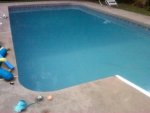At least I think that's the question I want to ask...
Here's the situation:
Yesterday, zero chlorine in the pool, water slightly greening.
I have been using the 60 algeacide for about a week now, did the original startup dose and followed up with maintainence doses. (Water still foams around the waterfall so I think I have enough residual?)
The filter runs about 12 hours a day, broken up into 4 hour segments.
So, I decide to shock it, poured 3-182 oz bottles of 6% original Clorox into the pool at about 1230 this afternoon.
Around 1830, I broke out my brand new TF-100 test kit and found out that I had a whopping 2.5 ppm FC in the pool.
According to the pool calculator, it should have raised it to 13 ppm. (I know 15 ppm is recommended, but I forgot to include the spa, tanning ledge, steps, etc into my calculations)
So, I retested. Same results.
Can that much chlorine waft away in 6 hours of full sun?
The water does look a 'lil better, but I'm concerned that I'll need to add another 4 gallons of bleach tomorrow. (Just joking... mostly)
The water's 62*, we aren't using it yet, and won't be until mid May or so probably. What's a decent minimum to shoot for with FC until then?
I read the CYA/Chlorine chart. That's FAR more ppm then I expected to have to maintain. My CYA is at around 90, so that puts my min FC at 6.6 ppm. How much bleach is that per day for a pool such as I have in my sig?
Here's the situation:
Yesterday, zero chlorine in the pool, water slightly greening.
I have been using the 60 algeacide for about a week now, did the original startup dose and followed up with maintainence doses. (Water still foams around the waterfall so I think I have enough residual?)
The filter runs about 12 hours a day, broken up into 4 hour segments.
So, I decide to shock it, poured 3-182 oz bottles of 6% original Clorox into the pool at about 1230 this afternoon.
Around 1830, I broke out my brand new TF-100 test kit and found out that I had a whopping 2.5 ppm FC in the pool.
According to the pool calculator, it should have raised it to 13 ppm. (I know 15 ppm is recommended, but I forgot to include the spa, tanning ledge, steps, etc into my calculations)
So, I retested. Same results.
Can that much chlorine waft away in 6 hours of full sun?
The water does look a 'lil better, but I'm concerned that I'll need to add another 4 gallons of bleach tomorrow. (Just joking... mostly)
The water's 62*, we aren't using it yet, and won't be until mid May or so probably. What's a decent minimum to shoot for with FC until then?
I read the CYA/Chlorine chart. That's FAR more ppm then I expected to have to maintain. My CYA is at around 90, so that puts my min FC at 6.6 ppm. How much bleach is that per day for a pool such as I have in my sig?



